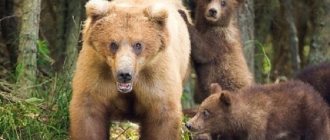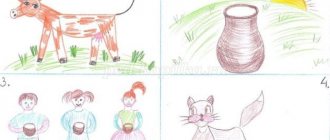Lapbook “Pets”
Ekaterina Alshantseva
Lapbook “Pets”
A laptop is a homemade book for self-study. Designed in the form of a cardboard folder with glued-on borders, retractable ribbons, pockets, etc. Nowadays, the lapbook is the most common teaching method.
a lapbook about pets for my kids . To create it, I needed two sheets of cardboard, colored paper, scrapbooking paper, tape, glue, scissors, felt-tip pens, a ruler, a pencil, the necessary printouts and, of course, a great mood and skillful hands. First, I made a folder out of cardboard and covered it with scrapbooking paper. In my lapbook I included educational games, pictures, riddles and poems, as well as coloring books and drawings. Here’s how it was:
Options for using the manual in a group and at home
As mentioned earlier, the benefit can be used not only in kindergarten, but also at home. Moreover, at different stages of consideration of the topic: when familiarizing themselves with the material, children can describe pictures and memorize poems. In the process of practicing the material - play, color, solve puzzles.
In this case, work can be organized both individually and in a group.
When preparing a lesson, the teacher can use a lapbook at each stage of the GCD. For example, to update basic knowledge, you can use riddles, at the main stage of the lesson - games, work with pictures, texts of fiction, and at the final stage - puzzles and/or coloring books.
Download and print all the pictures for the lapbook “Pets”
Download all the details in the “Pets” Lapbook collection.
Download all the details in the “Pets” Lapbook collection.
Download all the details in the “Pets” Lapbook collection.
For the lapbook “Pets.
Determine who left their traces in the picture.
The laptop is intended for preschool children. The collection includes 25 pictures, including interesting games and tasks: puzzles, puzzles, cards with pictures, puzzles, labyrinths and other game tasks for children.
This is what a lapbook spread looks like.
And this is a photo of tasks for the laptop pockets.
Cards with mazes
Photo portraits of animals (cards)
Game "Gather the Family." Mom and baby are on one card, you should pick up the card with dad
Puzzles on the topic “Pets
Source
Master class on creating a lapbook “Wild Animals”
Let's consider the option of compiling a lapbook, which can be called basic: it does not require much time to design it - it is made on the basis of a folder for storing files, and the form of organization of materials allows you to use the manual for several years, simply changing the contents of the envelopes.
You can add new materials to a lapbook based on a thick file folder without removing old ones - the dimensions allow
Materials and tools:
- thick file folder,
- envelope folders with buttons (different formats),
- scissors,
- glue gun,
- wide tape,
- double sided tape,
- colored cardboard,
- glue,
- printed names of the blocks of the manual,
- Pictures.
Instructions:
- On the front of the outer part of the folder we glue a picture with the caption “Lapbook Wild Animals”. It’s better to use wide tape for this: attach the picture and lay the tape on top. It is important to ensure that there are no air bubbles and that the tape does not bunch up.
For durability, pictures and names should be taped with tape.
- You can also stick the title of the manual on the spine.
- On the left flap we place ready-made plastic envelopes for game materials and texts for reading and retelling.
To rationally use the base folder, envelopes need to be selected in different formats
- On the right flap we have figuratively cut pockets for games, riddles, pictures, as well as finger gymnastics texts.
Envelopes can be signed with a felt-tip pen in a contrasting color or cards with printed names can be glued on
- We attach two envelopes with buttons to the outside of the folder at the back: one for coloring books, the second for pictures for the game.
Usually the envelopes on the back contain games or coloring books.
Photo gallery: samples of lapbooks on the theme “Wild Animals”
The younger the children, the more pictures the laptop should contain and the less text.
To decorate the folder, you can use self-adhesive, stylized wood
Pockets and envelopes must be signed
Pictures are used not only as teaching material, but also as a means of designing a manual.
For the spinning drum, you can choose a task to match the animal with its tail
The higher the level of knowledge of the children, the more blocks there can be in the manual
Video: review of materials for the “Wild Animals” lapbook
Lapbook “Wild and Domestic Animals” for children of the first junior group
SVETLANA CHAIKA
Lapbook “Wild and Domestic Animals” for children of the first junior group
Dear colleagues, thank you very much for your created laptops. Having used them and looked at them, I created my own laptop for my kids, which I am very happy about! I present to your attention the laptop “ Wild and Domestic Animals ” for children of the first junior group . This manual helps me in working with children both individually and in subgroups . Children play the proposed games with great interest.
My thematic folder contains the following games:
1. The game “Find My Shadow” develops logic, thinking and visual memory.
2. Lotto “ Animals ” develops fine motor skills and attentiveness.
3. Poems riddles about animals , promotes the development of the baby’s speech
4. The game “Collect pictures” develops fine motor skills, teaches you to connect parts of an object into one whole, and name the object.
5. Finger games “ Animals ” develop fine motor skills of the hands.
6. The game “Who eats what” consolidates children’s knowledge about what different domestic and wild animals ;
7. The game “Whose Tail” develops attention, logic, memory, fine motor skills
7. The game “The fifth odd one” develops the ability to classify animals according to essential characteristics
8. The game “Whose Baby” teaches children to correctly name animals and their babies ; guess the animal from the description .
9. The game “Who Lives Where” teaches children to distinguish forest inhabitants from pets children’s thinking, memory, speech , and cultivates interest in the natural environment.
This is the laptop I got!
Didactic game “Wild and Domestic Animals” for children of the second junior group Didactic game “Wild and Domestic Animals” for children of the 2nd junior group.
The game introduces children to domestic and wild animals and places.
Summary of the GCD with children of the first junior group for speech development “Pets and their cubs” Summary of the GCD with children of the first junior group for speech development “Pets and their cubs” Program content: Teach children to distinguish. Abstract of educational activities in the junior group “Wild and Domestic Animals” Integration of educational areas: social and communicative development, cognitive development, speech development, artistic and aesthetic.
Materials for the lapbook “Wild Animals”
The material bank can be replenished annually.
Information part
This block includes:
- general information about wild animals, including information about lifestyle, nutrition, etc.,
- information about unusual animals - these materials can even be included in a lapbook for kids,
- interesting facts about animals - such materials are used for teaching aids, starting from the middle group,
- materials about forest animals,
- information about exotic animals, including those that can be kept at home - the materials will be especially interesting for preschool children who dream of having a pet,
- rules of behavior when meeting a wild animal - this information should be included in lapbooks starting from early preschool age.
Poems on the topic “Wild Animals”
For kids, rhymes should not be too long:
- He walks through rubble and ravines with a master's step. The bear loves sweet honey and picks raspberries from the branches.
- The noise of the forest rolled through - The scythe fell silent under the bush. He pressed his long ears back and followed the echo for a long time.
- The little fox knows: All her beauty is in her fur coat. There is no red fur coat in the forest, There is no more cunning beast in the forest.
- Day and night he prowls the forest, Day and night he searches for prey. The wolf walks and wanders silently, with gray ears erect.
For older children there may be more lines, and the range of fauna representatives described is wider:
- What is this strange little deer? He decided that he was a donkey. He repeated all day: “I’m a donkey, I’m not a deer!” And then my mother said: “How stubborn you are! Almost drove me crazy. Maybe you’re really an ass?”
- Red squirrel with a red tail Found a little red squirrel under a bush. She salted the little saffron milk cap. I put it in a large jar. The squirrel is no longer afraid of the cold: she has food for the whole winter.
- A smart animal, the boar loves to tear up the earth. He finds underground, Something that can be eaten. Boars are strong and agile, they run quickly in the forests. They are not afraid of wintering either. The fur on boars is thick.
Riddle block
For children of the second younger group, the selection may be as follows:
- I am an orange animal, The fur coat is warm, like a hot water bottle, The tail is soft, like fluff, I am diligent... (squirrel),
- It is thorny, but not a Christmas tree, In needles, but not a pine tree. It can curl up into a ball. Of course it's... (hedgehog)
- Branches crunch in the forest, here and there. Looking for acorns... (boar).
For children in the middle group, riddles should be about animals that they know well:
- I am gray, I live in the forest, I know a red fox. I sing a sad song, howl loudly at the moon. (Wolf),
- There are workers in the river, not joiners, not carpenters. And they will build a dam, At least paint a picture. (Beavers),
- Jumper-coward: Short tail, eyes with a braid, ears along the back, clothes in two colors - for winter, for summer. (Hare).
You can include riddles about exotic animals in a lapbook for older preschoolers:
- It’s easy for us to recognize him, It’s easy to recognize him: He’s tall and sees far. (Giraffe),
- The horses put on nautical vests. (Zebra),
- He has a lot of strength, he is almost as tall as a house. He has a huge nose, As if his nose has been growing for a thousand years. (Elephant).
Games for the lapbook “Wild Animals”
The manual should include all types of games: didactic, active, theatrical and finger games.
Table: examples of games for the “Wild Animals” lapbook
| Name of the game | Rules | The target audience |
| Didactic | ||
| "Whose Shadow" | Children connect the shadow with the animal. | Junior, middle |
| “Recognize the beast by description” | The teacher describes the animal, the children guess what it is about:
| Middle, senior groups |
| "The Fourth Wheel" | Children look at the picture and choose the “extra” animal (usually the selection principle is based on what kind of animal it is: domestic or wild). Older preschoolers can complete the task at speed. | Middle, senior |
| Puzzles | The guys assemble an image from fragments:
| |
| Movable | ||
| “Animals gathered at the forest edge” |
| Second junior group |
| "The Hunter and the Hares" |
| Middle and senior groups |
| Theatrical | ||
| Imitation Games | Children perform movements in accordance with the text:
| Junior, middle groups |
| Finger | ||
| "Squirrel" |
| Junior group |
| "Hedgehog" |
| |
Photo gallery: materials for the games “Whose Shadow”, “The Fourth Wheel” and for puzzles
The game “Whose Shadow” can be played at speed
In the game "The Fourth Wheel" there is usually one domestic animal among the wild animals.
In the game "Odd Four" the guys train their reaction speed and logic
For kids, puzzles can be made from pictures, not photographs.
Children of the middle and senior groups can put together puzzles for a while
Literary works on the topic
Texts of fiction in the form of passages for retelling or in the form of a list recommended for reading with parents are necessarily included in the lapbook. The selection includes fairy tales and stories for children of all ages.
Visibility
The basis of the entire manual is clarity. On the one hand, it provides the aesthetic appeal of the lapbook, and on the other hand, it provides materials for working with children on the topic. Moreover, thematic pictures can be in the form of individual images of animals, or they can have a more complex form, for example, when the illustration shows at once images of the animal’s home, the cub, and the diet.
Photo gallery: examples of pictures on the topic “Wild Animals”
You can invite children to look at the picture and remember the poem about this animal
Looking at the picture, the guys can name fairy tales where this animal was a character
When talking about a wolf, children emphasize that it is a predator
The description of the animal must include its lifestyle at different times of the year.
The story about the animal includes a description of its appearance
In the description of the animal, older preschoolers include a list of the areas of distribution of the animal
Cartoons
The block of visual materials also includes a CD with video materials on the topic, work with which involves discussion after viewing.
Video: educational cartoon “Animals of Africa”
Video: cartoon “Tig and Leo” for the lapbook “Animals of the Taiga”
Video: cartoon “Kangaroo Family” for the lapbook “Exotic Animals”
Video: educational cartoon “Forest Animals”
Section with puzzles and coloring pages
Pictures for children of all ages and tasks for ingenuity for pupils of the middle and senior groups are also mandatory elements of the lapbook.
Photo gallery: a selection of pictures for coloring on the theme “Wild Animals”
In this picture, children practice the precision of strokes made with a black pencil
Children can make up stories using ready-made drawings
To add texture to the squirrel's fur, you can use the fork stamp coloring technique.
In addition to coloring, you can invite the children to remember an interesting fact about the animal
To color a wolf, you can use a simple pencil, varying the pressure to create shades of color.
For kids you need to select pictures with a small amount of detail; single-color large predators are suitable
It is important that children know exactly the name of the animal they are coloring.
Photo gallery: puzzles and crosswords for the lapbook “Wild Animals”
Crossword puzzles can be based on descriptions of animals, riddles
The answers to this puzzle are compiled according to the first letters of the names of the depicted objects
Answer: fox




